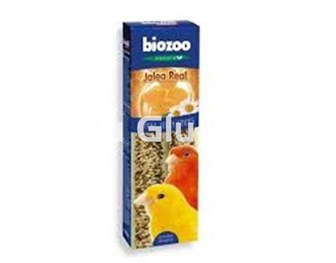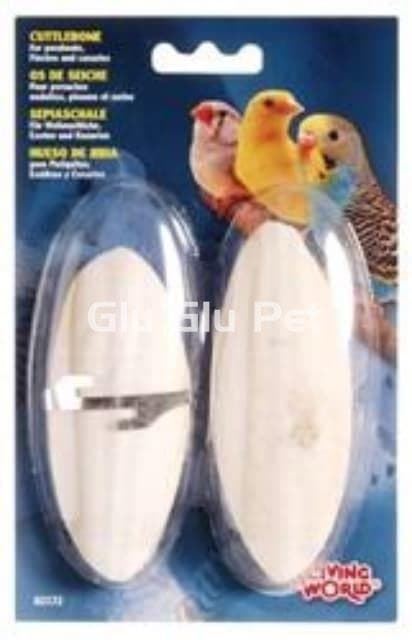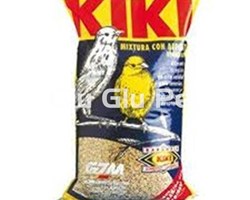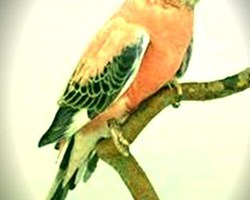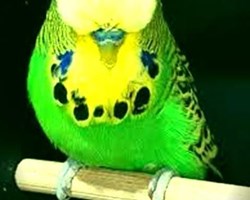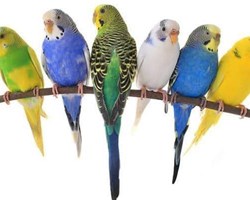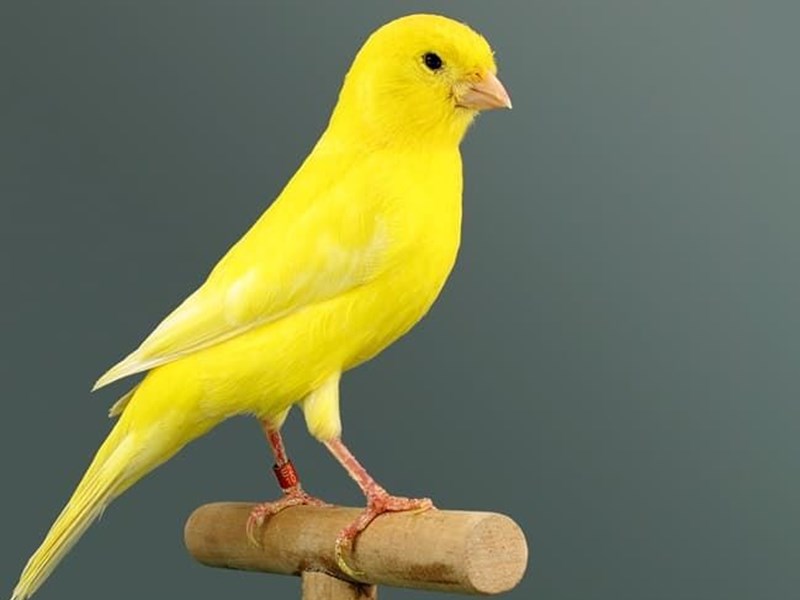
INDEX:
1.- DESCRIPTION OF CANARIES.
2.- BREEDS OF CANARIES.
3.- HOW LONG DO CANARIES LIVE?
4.- HOW TO DOMESTICATE A CANARY?
5.- MUTTING OF THE CANARIES.
6.- TIPS FOR HAVING A PET CANARY.
7.- CANARIES ALONE OR IN A PAIR.
8.- CANARY NUTRITION.
1.- DESCRIPTION OF CANARIES:
The domestic canary birds that are so appreciated for their song and for being lively, happy, sociable and easy to tame, take their name from the Canary Islands where they live free, wild and it is where the canary birds, called wild canaries, also live. in the Azores and Madeira. For all this and much more, they are the most beautiful birds in the world and their song is the most appreciated. This bird is one of the domestic birds in Spain that is kept as a pet but also in the rest of the world.
Canary farming is the branch of poultry farming that deals with the breeding of canaries and canary breeding methods.
The three types of canariculture are more concerned with a specific type of canary's characteristics, so they enhance that aspect of the bird above all:
- Singing canaries.
- Posture canaries.
- colored canaries.
2.- BREEDS OF CANARIES:
There are many types of canary birds and divided by their characteristics such as breeds of color, posture, their size, large or small, and their timbre or song.
Every time a new breed of these little birds or an extinct breed such as the London fancy is resurrected, a stir is formed in the canariculture community.
- The Australian Plainhead Canary is a breed of domestic canary that was bred for display purposes. The variety was developed through selective breeding and remains the only Australian Plains breed to have its roots in the Canary Islands. Which originated in Norwich, England and became a variety of popular shows in Australia.
In the 1930s, differences between the old show model used by breeders in Victoria, Australia and the more modern British standards created a bitter divide among Australian canary breeders in Norwich.
Decades later, after modern Norwich had largely displaced birds.
An old-fashioned Victorian scene, a club was founded in 1953 to preserve the ancient breed, which has been renamed the Australian Plains. By 1991, the number of Australian canaries in Australia had decreased to around 460 birds.Although the Australian Plainhead remains a rare breed, it is now much more common among breeding birds in Australia and the United States. The Australian lyre is a "canary type" that is judged primarily by its shape. However, the breed is also known for its color and the quality of its feathers. The Australian cannon can be green, blue (gray), yellow, white, tan, brown, and also variegated.
Show birds may be "colored" carotenoids during molt, giving new feathers an orange tint, but this is optional. The birds are displayed in a box-type cage with a white interior. The Australian Plainhead tend to do well with basic care and attention. While many other large breeds of canaries need foster partners to raise their chicks, Australian single heads are good feeders and often raise their chicks.
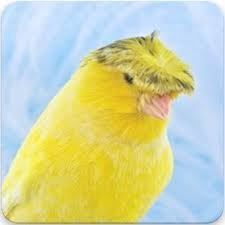
- The curly canary: from the south it was bred in France, it is a hybrid of the crossing of the curly canary from the north with the bossu canary, obtaining the two traits of both breeds. The curly plumage, the shape and position of the bird, make it of great interest to sports breeders. The length of this peculiar canary is 16 to 17 centimeters. The head is small and oval with a slender, forward-sloping neck. The body is upright in a figure 7 and the legs are long without feathers. It is marketed especially among breeders to achieve the preservation of the breed, because for many it is one of the most beautiful birds on the market. The colors of this bird are yellow, green and white. The plumage of this breed is smooth and compact on the head, neck, thighs, underbelly and undertail. On the neck, back and chest it is curly, better if it is symmetrical. The song of this canary is scarce but it is clear. Breeders appreciate this bird for the curly feathers and body shape. They are very delicate birds and sensitive to cold, they can have defects such as lack of curls and lack of rigidity in the legs. Many acquire a very forced posture that they cannot maintain, so they look for something to hold on to, such as the bars of the cage. For this bird we recommend this seed mixture that is special for canaries.
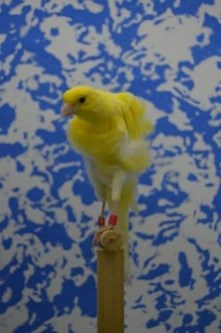
- The Paduan or Padovan canary: it is a bird resulting from the cross between the Parisian and the Saxon. He was raised by Italians in the city of Padua after the second world war. The variety of specimens can have great differences, but all with curly and bowed feathers. The minimum length of this bird is 18 centimeters, it is an upright bird, the legs are stretched out with regular claws, the tail is straight, well formed and fork-shaped.
The most attractive thing about this canary is undoubtedly the bow, which is round, dense, regular and well centered and often has a different color than the body's feathers. Breeders usually mate a canary with a bow with another without bows. This breed closely resembles the Curly in color. There are two types of Paduans, the shaggy-headed and the smooth-headed.
Paduan canaries are stronger birds than the Parisian, they need large cages for good reproduction. To obtain a good copy is an arduous task. The song is similar to that of the common canary but it is less vocal and with better quality.
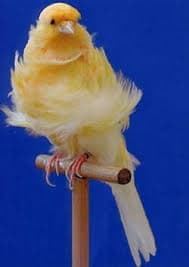
- The Saxon or common canary: it is a domestic bird and one of the best known pets in the world, a descendant of the wild canary that was bred in captivity by the Spanish, Italians and Germans. It is 14 centimeters long, the plumage is thick and close to green, grey, brown and yellow, its predominant color is yellow but you can get other colors such as red, giving it foods with red pigments, for example peppers and pasta. Breeding for canaries that helps maintain pigmentation.
The genus of this canary bird is serinus, which are small birds that many breeders have crossed with other breeds and obtained hybrid or mestizo birds.
The Saxon canary has a very strong, pleasant, sonorous, melodious and resonant trill similar to that of the goldfinch. It is an easy canary to breed because it is a very strong bird and a great breeder. This bird likes to bathe and spend time cleaning itself, so we recommend you take a look at the bathing trays or boxes that we recommend. It lays two or three times a year between the months of January and July. The first spawning usually takes place in March. In general, they lay four eggs, but this number can vary to 3 or 5. She is the main builder of the characteristic and elaborate nest that is shaped like a cup and that is usually placed at the end of branches in wooded areas 3 or 4 m wide. height. Incubation of these bluish-white eggs with reddish-brown spots lasts 13 to 14 days. The chicken leaves the nest in 2-3 weeks, during this period it is fed by its parents. Consume a mixture of seeds, especially canary grass, also accepting wild herbs such as cerrajas, vegetables such as lettuce, Brussels sprouts and broccoli, vegetables such as grated carrots and fruits such as apples, pears and oranges. There are commercial supplements necessary for moulting, which must be added to the mixture that is normally administered.
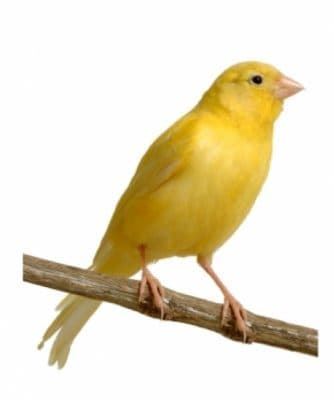
- Lancashire canary : In the United Kingdom, more specifically in Lancashire, the Lancashire canary was bred, obtained from the cross between the Dutch and the bossu. During the First World War its birth rate began to decline and for a time it was considered extinct, thanks to the efforts of the breeders they got the breed again.
It measures around 22 centimeters, it is a bird of considerable size, so we recommend having aviaries. Males with snowy plumage usually measure more. Standing upright, its head is larger and it has a bow that falls over the beak and eyes without covering them. The legs are of normal size, the tail is quite thick and long, just like its body. It is very difficult to breed as it is the result of several crosses and hereditary defects.
Its feathers are ornate and long, light yellow. In the contests, the specimens with a light tone and a dark bow were more valued, causing the problem that the quality of the plumage diminished, making it necessary to cross birds with and without a bow because in reproduction it is essential. Poor in singing but regardless since it is a canary of posture and tufted, more was sought for its physical aspect than singing. Below you have a video of the lancashire singing.
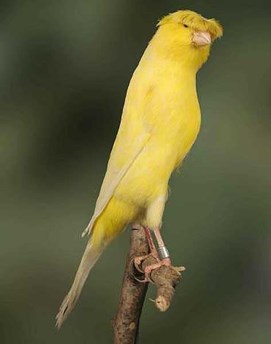
- The Scotch fancy canary: it is a posture canary bird, derived from the crossing of Dutch canaries with the Glasgow don, which is a local breed and after a subsequent crossing with the bossu led to the creation of the scotch fancy.
The length of this bird is around 16.5 centimeters. The head is oval and small and leans far forward, the shoulders are narrow and prominent. The legs fully extended and are almost parallel to the back and tail line. The upright position is in the form of an arch and its tail is long and collected.
Cougars are short and close to the body. It is a colored canary, its most common color being yellow, green and white. Its singing skills are very poor, however this canary is valued for its shape. It is a difficult bird to breed, so it is a canary normally bred by expert breeders. In our store you will find everything you need to breed this breed and other breeds of canaries.
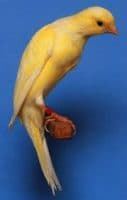
- The red factor canary is a hybrid that was crossed with exotic birds, which after mating created this red bird that breeders of canary birds like so much. This breed is a derivative of the Saxon that are identical, except for the red color of this fantastic bird. It must be clarified that the red plumage in the ancestral canary does not exist, by including red pigments in their diet they acquire it, if they remove them they lose that characteristic. It is quite common to cross them with Venezuelan Cardinals, a bird with red feathers from birth. This bird is 14 centimeters long like the common canary, its plumage is thick and close-fitting. It has three types of red orange red, reddish orange and orange, which are divided into two groups light and dark background. The clear background is lipochromic type (fatty pigment, which provides the background color to the plumage of all birds) Those with a dark background are divided into four types: bronze, brown, agate and yellowish white.
Today it is easy to find a red factor canary for sale at a very good price. You can find them both in a conventional store and through the Internet at a price of 18 to 50 euros. There are more and more breeders of this variety and it makes it easy to find. The canary red factor has various shades or intensities of color, so no sample is the same as another. It is one of the most sought after colors by fans, along with yellow, as its aesthetics are truly amazing.
Your diet of fruits and vegetables are important for your good health. Feeding colored foods to achieve the deep red pigment are: bell peppers, cherries, cayenne pepper, beets and any other natural red food will help change the color of this bird, you can also give it red paste. Color feeding should begin around molting time, when the canary is producing new feathers. The color will not appear on feathers that are already on the bird's body. The red factor is an enzyme system, that is, a biocatalyst that some birds have, the tropical ones with a red background and those that do not have others, those with a yellow background. To obtain red canaries it is necessary to introduce this enzymatic equipment in the native species, and such a biochemical miracle could only be achieved through hybridization with tropical birds with a red background, achieving hybridizations with the possibility of offspring is complicated. The sonorous and pleasant song similar to that of the Saxon is not of the same quality, although very similar. It is easy to breed and reproduce. The difficulty is to select specimens with the characteristics that we want for our bird.
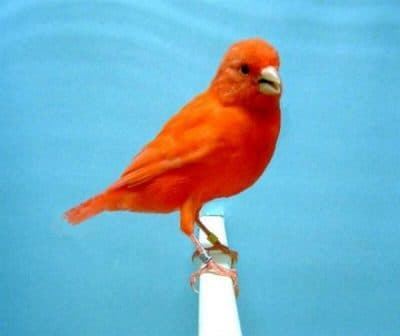
3.- HOW LONG DO CANARIES LIVE?
This is one of the questions asked by many people who want to have a little bird.
This little bird in good conditions of hygiene, food and space in the cage can live from 10 to 15 years, it is highly recommended to have them in aviaries for canaries for greater comfort of the birds.
If the bird is in poor condition, obviously the years of life of the animal are reduced.
It also depends on what species of canary it is, since there are some more fragile ones that live an average of 8 years, such as the bossu and melado canary.
4.- HOW TO DOMESTICATE A CANARY?
If we want to tame these noble birds, above all we need patience and perseverance.
To begin with, we introduce a hand into the cage until the bird calms down, then we offer it a seed, holding it with our fingers through the bars of the cage and if it accepts it, all that remains is to wait for it to gradually get used to its new life in captivity.
5.- MUTTING OF THE CANARIES:
The canary sheds its plumage once a year.
This development, which begins in the middle of summer and lasts about eight weeks, is very tiring for this little bird, so it will not sing or sing less.
During this period, periodic bathing is essential, since this promotes the change of plumage.
To make it more satisfying for the bird, you can fill its bath twice a day with clean, not too hot water.
Make sure there is no draft when the bird is wet on its stick, lest it catch a cold.
The moulting season for canaries begins in June and will last from 1 to 3 months, with a general duration of 2 months, it also depends on the breed of canary.
Throughout the molt you have to take even more care of its nutrition.
There are food supplements that assist birds throughout the molt, they offer the necessary vitamins and minerals.
What is truly effective is to put another small feeder to supply the small doses that the bird needs.
6.- TIPS FOR HAVING A PET CANARY:
In the first place, at Glu Glu Pet we believe that we must take into account that they are not multi-care birds and that it depends on the kind of canary we have, which is why they are appropriate birds for those families who wish to have a first animal to office.
A well cared for canary can live up to 15 years.
If you decide to have this wonderful bird, the first thing you have to do is acquire a very large birdcage, with plenty of horizontal space because they require enough space to fly every day and thus maintain optimal health.
Make sure that the cage does not have a division between bars greater than 12mm.
It is also important to take into account that the cage is equipped with safe toys for them to entertain themselves.
Canaries are very strong and adjust to a huge range of temperatures, but it is always preferable to keep the cage careful of drafts or air conditioning, so when ventilating a room you have to remember to move the cage to another quarter.
In addition, it is necessary to remember the circumstance of the cage knowing its exposure to the sun so that the bird does not suffer from overheating.
7.- CANARIES ALONE OR IN A PAIR:
This is a question that many ask themselves before having a canary, at Glu Glu Pet we give you the answer to this easy question, the ideal is to have them as a couple.
The reason is that these little birds are very sociable and having them alone is torture for them, so if you have a canary, the ideal is that you acquire another to keep it company.
8.- CANARY NUTRITION:
The canary's nutrition is fundamentally based on seed bars known as bird trinkets.
Keep in mind that there are several types of bird food.
As a complement, they could be provided with fruit and pieces of hard-boiled egg from time to time.
Which get the color through crosses such as white, red, yellow and any of their compositions.
The males have a more interesting voice than the females with a more extensive repertoire, but they usually stop singing when the molting season arrives.
With these tips we assume that before acquiring a canary it will be easier for you to understand its needs and create a suitable space for the bird.
In this way, take into account its nutrition to have a healthy canary, especially taking into account the breed of canary that we have.

